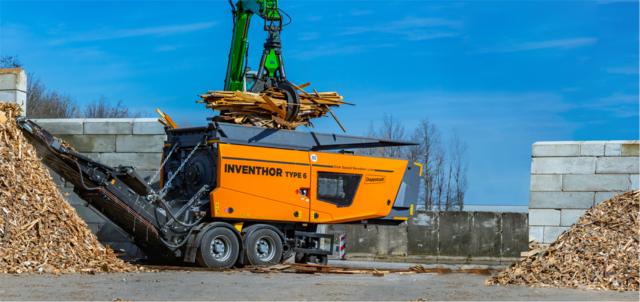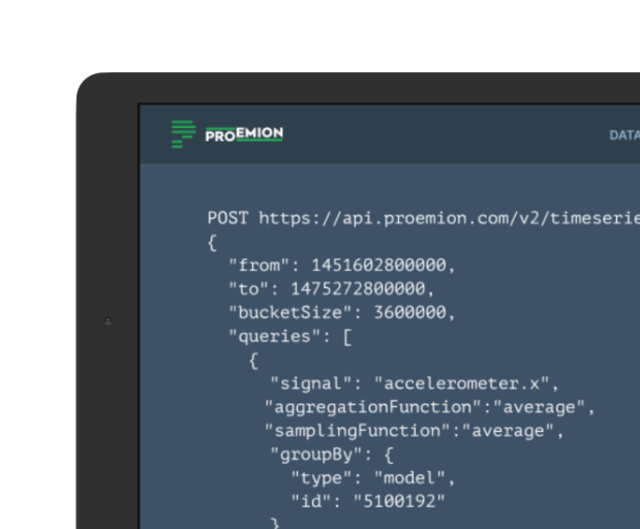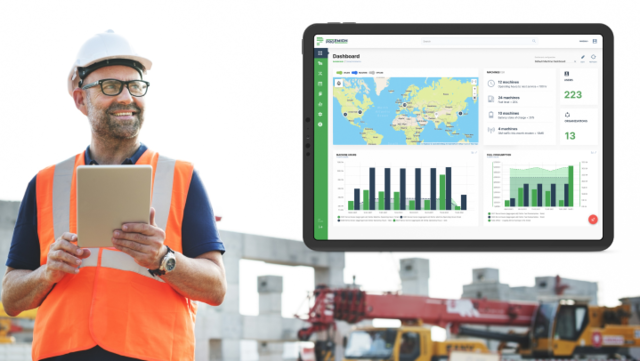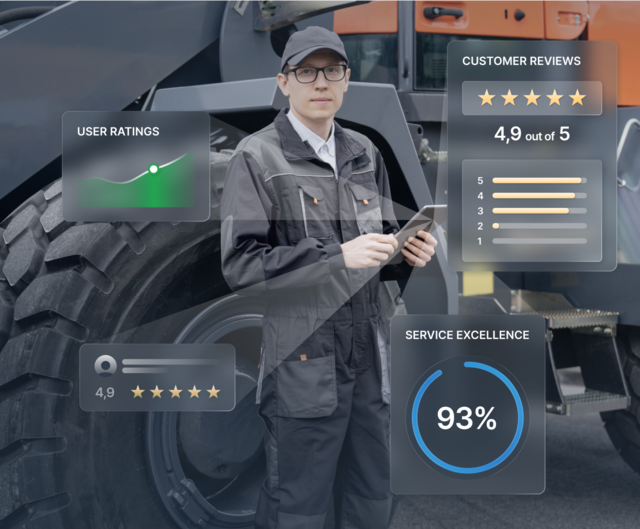The future of telematics for OEMs
Exploring the potential of basic versus advanced telematics solutions for OEMs beyond fleet management in the digital age.
Introduction
Telematics, the technology combining telecommunications and information processing, has revolutionized how businesses manage their fleet operations. But with the rapid advancement of telematics, it's essential to understand the difference between basic and advanced telematics solutions. In this white paper, we explore the benefits and limitations of both basic and advanced telematics and discuss the possibilities and technological innovations advanced telematics can offer you.
This whitepaper will begin by briefly introducing telematics, including its current usage in the off-highway OEM industry. It will then delve into the definition of basic and advanced telematics while highlighting the differences between the two technologies in a concise manner.
Following this, it the whitepaper will provide an overview of the current state of telematics technology, discussing what is currently possible and where the future of the industry is headed. This outlook will include an explanation of how businesses can get started with advanced telematics and prepare themselves for future innovations.
Finally, the whitepaper will showcase some of the most useful and exciting possibilities advanced telematics can offer to the off-highway OEM industry. This will help businesses better understand how they can utilize this technology to improve their operations and stay competitive in the market.
What is Telematics? What is for?
Telematics is the use of information technology to transmit and receive data between remote locations. It combines telecommunications and information processing to provide real-time communication and information exchange.
Telematics is widely used in vehicle tracking and management, remote monitoring of industrial equipment, and safety. Telematics systems in vehicles provide features such as real-time tracking, remote diagnostics, and safety features. The data collected is processed and analyzed to generate reports and alerts, enabling informed decision-making.
A telematics system consists of a telematics control unit (short TCU) connected to the CAN Bus device (Controller Area Network), a central communication system that gathers and transmits data from a vehicle’s network. It then processes and transmits this data to a central server. From there, it will be forwarded to the system or platform designated for accessing the data, for example, the cloud, web applications, or service tools.
Telematics also has applications in healthcare, where it can be used to monitor patients and track vital signs remotely. In addition, it can improve safety in hazardous environments and provide real-time traffic updates to drivers.
In short, telematics delivers important insights by collecting and transmitting information that could otherwise not be tracked without close human supervision, thereby making it an essential part of various industries and businesses.
Telematics in the off-highway Industry
The off-highway OEM industry is highly competitive. To stay ahead of other businesses, OEMs need to constantly monitor and optimize the equipment performance of their machinery, which has led to telematics systems becoming an essential tool in this industry. They are installed in equipment such as construction machinery, mining equipment, and agricultural vehicles to provide a wide range of features.
One key application of telematics in the off-highway OEM industry is remote monitoring and diagnostics. With the data collected via telematics, manufacturers can identify issues before they become serious problems and optimize maintenance schedules. Telematics can also track equipment usage, enabling manufacturers to understand better how their equipment is used and to develop more efficient models.
Another critical application in the off-highway OEM industry is safety. Since telematics systems can provide real-time information on equipment operation, they enable manufacturers to identify potential safety hazards and take corrective action. For example, a manufacturer can monitor driver behavior and provide feedback on safe driving practices to their customers.
Telematics can also unlock new business opportunities for OEMs and increase sales opportunities by offering its customers efficiency and productivity improvement, for example, by tracking equipment location and optimizing routes, reducing fuel consumption and costs. Additionally, telematics can support OEMs by automating equipment maintenance and repair processes, which reduces downtime and additional expensive on-site repairs. This process can also be tied to increasing sales of original spare parts, positively affecting overall revenue. To learn more about all the ways telematics can level up your service department, read our white paper on Service Excellence.
In conclusion, telematics has emerged as a vital asset for the off-highway OEM industry, providing various ways to improve performance and optimize processes. Because of this, this technology offers businesses a significant advantage in a highly competitive industry.
Difference between basic and advanced telematics
The difference between basic and advanced telematics lies in the level of functionality and data analysis the system provides. Basic telematics systems typically offer features such as GPS location tracking, vehicle speed, and trip distance. They may also provide alerts for speeding, harsh braking, or sudden acceleration. In contrast, advanced telematics systems provide more comprehensive features such as remote diagnostics, driver behavior monitoring, and predictive maintenance.
The reason for this lies in the way telematics solutions are implemented. Basic telematics devices are usually applied post-manufacturing by attaching them outside the machine. On the other hand, advanced telematics devices are being built-in during machine manufacturing. Because of this difference in implementation, each telematics solution has different benefits and downsides.
Since basic telematics devices are attached to machines after manufacturing, they are an excellent option for retrofitting any fleet or equipment. However, they provide information from observing the machine, e.g., vibrations from the running motor. This also means that the scope of possible data is limited since there is only so much a device can track from outside the machine.
In contrast, advanced telematics solutions collect their information directly from the machine's TCU. With the telematics device built into the heart and connected to everything inside the machine, the data is provided straight from the source. As a result, this provides you with much more insights into the machine and more accurate data since information like, for example, fuel consumption is not estimated by the motor's running time and the vehicle's speed but is directly collected from the machine’s tank. However, even though this solution is more accurate and detailed, advanced telematics devices are not a retrofit option because they must be built during manufacturing.
Benefits of advanced telematics
Advanced telematics systems offer a range of benefits for machine manufacturers. These systems provide more comprehensive data analysis and functionality than basic telematics systems, which can help companies to optimize their operations and reduce costs.
One of the main benefits of advanced telematics is the ability to monitor and analyze equipment performance in real-time with information directly provided by the machine. This can help businesses identify potential problems before they occur, reducing the risk of unplanned downtime and costly repairs. Advanced telematics can also provide predictive maintenance alerts, allowing businesses to schedule maintenance proactively, offering preventative service and thereby increasing business opportunities.
The valuable data provided by advanced telematics allows businesses to make the most informed decisions and take precise action. With detailed reports on equipment and vehicle usage, they allow businesses to identify areas for improvement and optimize their operations. They can also be integrated with other business systems, such as fleet management and asset tracking, providing OEMs with the opportunity to diversify their product portfolio to offer their customers additional useful features.
The next step then is to use advanced telematics information to automate processes, control machines remotely, predict machine behavior, and many more innovations to come. With the insight into everything happening in the machine, operating the machine without manual labor on the worksite is possible. Moreover, maintenance tasks can be predicted precisely and scheduled in time to prevent costly machine breakdowns.
Machine Performance Monitoring
Avoiding major problems and optimize machine performance.
Predictive Maintenance
Reducing downtime and maintenance costs.
Remote Diagnostics
Reduce the need for costly on-site visits.
Improved Customer Service
Proactive and efficient customer service.
Data-driven Decision Making
Informed decisions on product development.
Increased Efficiency and Productivity
Improved business operations and profitability.
Paving the way for advanced telematics
Innovation is always a process. Many advanced technologies, such as automated driving and predictive maintenance, will benefit the off-highway OEM industry – and eventually, become the standard – are already being discussed. Though the details still need to be figured out, the basic tool necessary for each development is already well-known – data.
Accurate data that is accessible in real-time is crucial for all machine and process innovations. They provide insights on what is and is not working, which process is initiated at what point, and, eventually, allow for precise prediction of machine behavior. Since it all comes down to data, there are three important steps to take in order to make the transformation towards advanced telematics solutions possible:
Step one is collecting correct and clean data directly from the machine. This is the groundwork for everything that follows afterward, so it is useful only if the data collected is impeccable and reliable. Therefore, appropriate hardware in the form of a TCU (hardware) tied to a CAN Bus is essential. Incorrect data lead to incorrect analyses and predictions, which defy the entire purpose of the process and will not achieve the desired results.
Step two is processing the data and making it available for analysis. This necessitates a proper infrastructure, which is able to process the amount of data collected in step one. Without the infrastructure capable of this in place, the full potential of the data collected cannot yet be realized because it is not fully accessible.
Step three, then, is to visualize and manage the data in order to analyze and work with it. This requires some sort of portal or platform that makes the data assessable for the OEM, so that he can actually draw conclusions and make data-driven decisions.
While the full potential of advanced telematics may not yet be available, the groundwork for these innovations is already in place through advanced data collection. For example, Proemion's advanced telematics solutions are built into machinery, allowing businesses to gather all the necessary data for future innovations. This data offers insights into machinery that not only pave the way for the future but also benefits businesses today.
Get started with advanced telematics today
The Proemion CANlink® mobile, a telematics device gathers information directly from the machine and bring them to the cloud-based DataPlatform opening the door to the world of advanced telematics. This gives businesses access to data that conventional basic telematics solutions cannot provide. By utilizing these solutions, businesses can enhance their operations through improved performance, efficiency, and productivity while preparing for tomorrow's advanced technologies. For instance, most maintenance service processes can already be automated, remote services offered, machine performances monitored and optimized, and business costs reduced. These are only a few examples of what you can already achieve today with the most advanced telematics solution on the market.
Moreover, thanks to the bi-directionality of the Proemion telematics solution, an advanced level of communication between machines and man is already established as well. This means that in addition to receiving information, companies can instruct their machinery and update the software as needed, which is a crucial step in paving the way for advanced technologies.
These two features of the Proemion telematics solution – the hardware being built into and directly connected to the machine as well as the bi-directionality – provide you today with the data needed for future advances and prepare your machines for any technologies to come, such as the ones listed below.
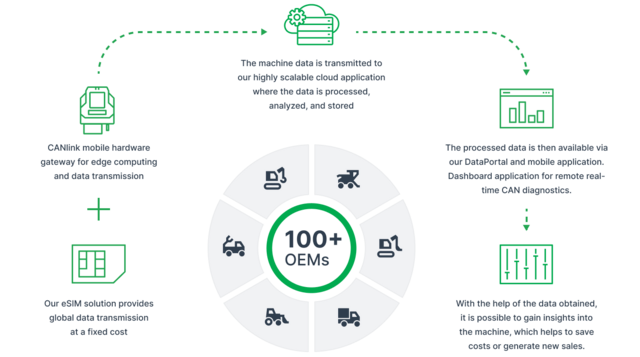
Data Science
Data Science is an interdisciplinary field that involves extracting insights and knowledge from data using scientific methods, processes, algorithms, and systems. It encompasses several fields such as statistics, mathematics, computer science, and domain-specific knowledge to make sense of the complex data collected. By leveraging various techniques to identify patterns, trends, and relationships in data, it enables organizations to make data-driven decisions. These techniques include data mining, machine learning, statistical modeling, visualization, and predictive analytics. Data Science also involves data cleansing, processing, and preparation to ensure that data is reliable, accurate, and consistent.
Proper data science creates the baseline for the three following examples of beneficial innovations in the off-highway OEM industry.
Automating off-highway vehicles and equipment through advanced telematics solutions could transform the industry. With the advent of self-driving vehicles, human operators would become less necessary, leading to improved efficiency and productivity. By using a combination of GPS, sensors, and advanced algorithms, these vehicles can navigate and operate autonomously, reducing the need for human intervention. Moreover, this automation technology enhances safety by reducing the risk of accidents caused by human error. As a result, advanced telematics solutions are eagerly awaited by the off-highway industry and are already heavily discussed during industry-relevant exhibitions.
Advanced telematics solutions can revolutionize the way off-highway vehicles and equipment are controlled and monitored. Remote control capabilities provided by these solutions can enable organizations to operate and monitor their machinery from anywhere in the world. This makes this feature particularly useful for organizations that have multiple sites or locations, as it allows them to manage their assets centrally. Already today, remote machine monitoring is possible with Proemion’s Global OEM Telematics solution for OEM, which opens the way for remote control.
In the future, the remote control feature could also improve safety by omitting the need for personnel to be physically present on-site. Additionally, it can help to reduce operating costs by allowing for more efficient use of resources.
Machine learning algorithms will be essential to advanced telematics solutions in the off-highway industry. These algorithms can provide valuable insights and predictions by analyzing vast amounts of data collected from vehicles and equipment. This enables organizations to optimize operations, reduce costs, and improve efficiency. Machine learning algorithms can also identify patterns and anomalies that might not be visible to the human eye, helping to identify potential issues before they become significant problems. By harnessing the power of machine learning, organizations can improve the reliability and safety of their equipment while maximizing their productivity.
This process can be supported by storing all the data collected on one singular platform. For example, Proemion’s telematics solution includes the DataPlatform, a secure and scalable platform that allows you to manage and store all the data the CANlink ® mobile devices collect. You can learn more about the DataPlatform here.
Data Integration
Data integration combines data from different sources, formats, and locations and transforms it into a unified and consistent view. Data integration aims to provide a comprehensive view of data to support business intelligence, analytics, and decision-making. This involves extracting, transforming, and loading data from various sources into a common data model. Data integration can be achieved through various methods, such as manual data entry, data warehousing, data migration, and data virtualization, and allow for the introduction of beneficial features such as interoperability.
Already today, Proemion uses the REST API to make this possible. As the standard interface between Proemion’s DataPlatform and various web interfaces, it delivers the data where you need it.
Interoperability offers integration with other systems and technologies, enabling organizations to access more comprehensive data and insights. This integration capability helps organizations maximize their data's value, as they can combine telematics data with data from other systems, such as ERP or maintenance management software. The resulting insights can provide a holistic view of operations, enabling organizations to make better-informed decisions. Interoperability also helps organizations to future-proof their investment in telematics solutions by ensuring compatibility with new and emerging technologies.
Proemion’s DataPlatform offers seamless machine and third-party data integration into other suppliers’ web interfaces through the standardized AEMP API, simplifying data sharing without additional effort. The DataPump securely streams machine data directly into your existing systems, enabling efficient analytics and data consolidation in your preferred on-premise or cloud environments. You can read more about them here.
Data Analytics
Data analytics is the process of analyzing and examining large and complex data sets to extract insights and draw conclusions. It involves using various statistical and quantitative methods to identify patterns, trends, and correlations within the data, providing valuable information for decision-making. Data analytics encompasses several fields, including business intelligence, data mining, and predictive analytics. With technologies like real-time data analysis, organizations are able to identify and solve problems, improve operations, and optimize performance.
Proemion offers the DataPortal as a means of visualizing and managing the collected data and making it easily assessable for OEMs.
With real-time data analysis, organizations can monitor and analyze their operations as they happen. This feature allows businesses to make data-driven decisions in real-time, improving efficiency and productivity. By analyzing data in real-time, they can identify potential issues and take corrective action immediately, thereby reducing downtime and increasing uptime for instance. Real-time data analysis also enables organizations to track key performance indicators, such as fuel consumption and equipment utilization, providing valuable insights into their operations. As a result, organizations can make informed decisions, optimize their operations, and reduce costs. This also opens the door for more business opportunities, especially in the service department. For example, since you constantly receive information on each machine parts’s performance, you could link that to original spare part selling.
Service Excellence
Service excellence is vital for the success of off-highway OEMs. In a competitive market, providing exceptional service can set OEMs apart from the rest. Offering reliable and responsive support, as well as expert guidance, can build trust with customers and foster loyalty. Furthermore, service excellence is crucial in ensuring that off-highway equipment performs to its maximum potential. By providing timely maintenance, OEMs can improve uptime, reduce repair costs, and ultimately increase customer satisfaction.
With advanced telematics, service excellence can be brought to the next level by not only automating the whole process, but also predicting service and maintenance needs.
If you want to learn how you can already achieve service excellence today by taking advantage of all the possibilities telematics offers in the present and thereby increase your business opportunities, read our comprehensive white paper on “4 ways to achieve service excellence”
Predictive maintenance solutions can use real-time data to predict when maintenance is needed and schedule it proactively, reducing downtime and prolonging the life of equipment. By analyzing data provided by the machine, these solutions can identify potential issues before they become major problems, enabling organizations to take corrective action before a breakdown occurs.
Thereby, predictive maintenance can help OEMs to reduce costs associated with maintenance. By scheduling maintenance proactively, organizations can avoid costly unscheduled downtime and emergency repairs, making it also extremely beneficial for their customers. Additionally, predictive maintenance can help to identify the root cause of issues, enabling businesses to take corrective action to prevent future problems.
Another benefit of predictive maintenance is that it can help to extend the life of equipment. By identifying potential issues early and addressing them promptly, organizations can reduce wear and tear on their equipment, prolonging its lifespan. This highly increases customer satisfaction and retention.
Conclusion
These topics discussed so far are already addressed in the industry and are the subject of various industry-relevant panels and exhibitions. It will not be long until these technologies are unlocked and available for the industry and off-highway OEMs – especially, since they are already partially realized. Therefore, it is crucial to start thinking of the future today and consider whether your business is prepared for future innovations.
As shown here, the first steps towards advanced telematics are already achievable with Proemion’s telematic solutions. Our solution covers all three steps integral to advanced telematics by collecting, processing, and visualizing clean machine data. Moreover, since they are built into the machinery, they collect first-hand data from the machine, making it clean and reliable.
Even though not all data possibilities are available yet, Proemion’s solution already offers a variety of benefits to OEMs that help maximize productivity and efficiency, reduce cost, and increase customer satisfaction. By implementing the most advanced solution on the market today, you will not only future-proof your business and secure its success but can start reaping the benefits immediately, giving you an edge over your competitors both today and in the years to come.
So get started today by taking full advantage of the most advanced telematics solution on the market.
Are you ready to level up your service department?
Contact our experts, they are ready to level up your business with our telematics solution tailored specifically to your business needs.
